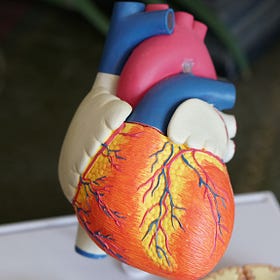How Type 2 Diabetes Puts On The Path To Heart Disease
The key is in the chronically prolonged state of diabetes
We know of Type 2 diabetes (T2D) as an issue with excess glucose in the blood. Glucose is highly reactive and can react with a ton of different biomolecules in the blood - one of the main biomolecules that it hits is the haemoglobin protein, and that’s why diabetics have to contend with their HbA1c markers:
We Live In A World Drugged Out On Sugar, And We’re Silently Paying The Price For It.
We face an endless barrage of sugar at every turn. The doughnuts in that picture look great, don’t they? What about the sugar in ice cream? Other cakes and pastries? Chocolate bars? Fruits? Cereals? Juices and soft drinks? Wherever we go, we are bombarded by it, much like how scantily dressed women are seen in many different advertisements today.
Simply put, the HbA1c marker is an indicator of how much haemoglobin protein has reacted with glucose (and therefore rendered useless in transporting oxygen about in the blood). Higher HbA1c values do indicate poorer oxygen transport capabilities, and a risk of lower limb amputation upon accidental cuts or wounds to the leg region:
Why Diabetics Are Likely To Face Future Issues With Limb Amputations.
Apparently, maggot debridement therapy is a mode of treatment for diabetic patients with foot injuries. According to this article: In maggot debridement therapy, sterile maggots are used to clean up a wound as the maggots are able to break down dead tissue and speed up the healing process.
But then it doesn’t happen just like that, overnight.
In a healthy human body, insulin is a biochemical that is produced from pancreatic beta cells and signals our cells to take in glucose from the blood at appropriate times. For the most part, each cell is obedient to the signal. Things work smoothly and are humming along. Blood glucose levels are well maintained at healthy levels — a more technical description of the entire process is found in this journal article here.
However, an unhealthy human body can be experiencing this situation known as insulin resistance:
What Is Insulin Resistance In The Body All About?
There has been much commotion about rape culture and sexual violence these days. A lot of the (unfair) blame has been placed on women who dress sexy, and men who end up giving in to their urges - as if it was the man’s right to do what he wanted. Is it the case that every woman who dresses sexy is begging to be raped or harassed by a man?
This article indicates that an increased secretion of pro-inflammatory cytokines such as tumour necrosis factor alpha (TNF-α) and interleukin 1-beta (IL-1β) are responsible for triggering the insulin resistance problem.
It is also possible that increased IL-1β levels also interfere with the beta cell ability to produce insulin. In fact, obesity can contribute further to insulin resistance as fat cells are known to aid in the production of IL-1β. This increased IL-1β production attracts the attention of the immune system’s macrophage cells:
This initial event may then lead to IL-1β-induced chemokines, resulting in the recruitment of macrophages. Subsequently, macrophage influx and activation within fat tissue may act as a prominent source of IL-1β secretion, triggering insulin resistance.
When the macrophages are involved in this activity (which is a vicious amplification loop where IL-1β is continuously being ramped up), their main role of “detecting, engulfing and destroying pathogens and apoptotic cells” is reduced, mainly because they are busy doing this other work of producing IL-1β.
Not only would the macrophages ramp up IL-1β production, they would also swarm oxidised low density lipoprotein (LDL) particles. This continuous feedback loop eventually results in the formation of foam cells - the precursor to atherosclerotic plaque formation:
Now, Seriously, What's So Tricky About Cholesterol?
This article is the final part of a 3 part miniseries. The first 2 parts can be found at: Medical science has been talking about cholesterol and its links to heart disease for years. People who are at risk of heart failure are invariably prescribed medicines such as
Therefore, it is easy to see how one with prolonged Type 2 diabetes can proceed on into an ugly situation of heart disease, especially when the underlying inflammatory factors have not been dealt with.
That is definitely something that we do have to watch out for, because the doctors don’t necessarily make these links apparent to us.
But we do need to know, again, that the functioning of our immune system is key for preventing the development of these health issues - and again, dealing with the inflammatory signalling is much easier said than done!
Do feel free to refer to 10 Nutrients That Support A Healthy Heart to see how we can better manage our diet to support a healthy heart!
Also do feel free to share this article and hit the “subscribe” button to get more updates about the science concepts in nutrition and health, all deconstructed nicely for your convenient perusal!








